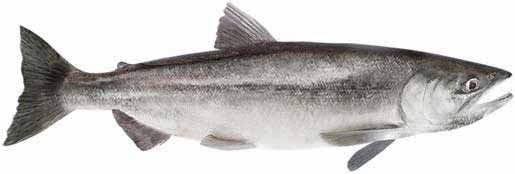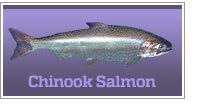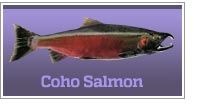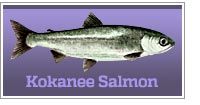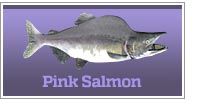Fishing For California Salmon
Guide to chinook, coho and kokanee fishing in CA
Much of the salmon fishing in CA takes place in rivers running to the Pacific Ocean. The Sacramento River, Klamath River, Smith River, and others are favorites. The purpose of this page is to share basic information about salmon fishing and identify popular salmon waters in the state. For those who prefer to fish for salmon in lakes, here are some popular options to consider.
California is renowned for its exciting salmon fishing opportunities, attracting anglers from all over. The state boasts several species of salmon, including Chinook (King) salmon, Coho (Silver) salmon, and occasionally Pink salmon. These species are highly prized for their size, fighting ability, and delicious flavor.
Chinook Salmon
One of the most sought-after salmon species in California is the chinook salmon, also known as king salmon. These powerful and impressive fish can reach impressive sizes and provide anglers with thrilling battles. Lake Michigan's deep waters and nutrient-rich environment create the perfect conditions for chinook salmon to thrive. Anglers often target them by trolling with downriggers or casting spoons and crankbaits.
Chinook Salmon, like all Pacific salmon, die after spawning. They grow large and put up a great fight when hooked. Fish for chinook with down riggers to troll around the thermocline. Use flashers, trailed with bait for best results. The current California state record for chinook salmon stands at over 44 pounds.
Coho Salmon
Another species of salmon found in California is the coho salmon. These coho's can are often more available to be caught during the fall when they migrate closer to the shoreline. These acrobatic fish put up a fierce fight and are highly prized by anglers. Trolling with spoons, plugs, or flies is a popular method for targeting coho salmon.
Coho Salmon are smaller in size compared to other salmon but still provide a thrilling fight when hooked. Coho salmon, also called silver salmon, are another prized species targeted by anglers in California. These fish are known for their aggressive nature and aerial displays when hooked. Coho salmon offer thrilling battles, often leaping out of the water and making blistering runs. They can be caught by trolling or casting near shore areas during their migratory periods. Use small spinners, or bait on a bobber setup. Good bait options include wax worms, minnows, shrimp, and nightcrawlers.
Kokanee Salmon
Kokanee salmon, a landlocked form of sockeye salmon, can be found in lakes. These fish are prized for their brilliant red color and tasty flesh. They are not the same as the ocean-run salmon species, but they still provide an exciting angling experience. Fish for them around structure with distinct drop-offs and depth changes. Typically kokanee average one to two pounds. They are plankton feeders and very sensitive to water temperature. They school in lakes at depths which remain ideal temperatures. Once this depth is identified, schools can be found where they are easily caught. Use small lures trolled at the appropriate depth. The can also be caught using corn, but the main way they are caught is using flashy lures which they attack when the lure intrudes their space. Kokanee salmon are known for their hard-fighting nature, making them a sought-after catch among anglers. Anglers can target kokanee salmon using techniques such as trolling with flashy lures or using downriggers to reach deeper waters where the fish reside.
Salmon Fishing
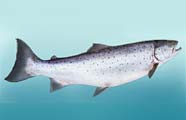 California's rivers and streams, particularly those along the northern coast, provide prime habitat for salmon. The Sacramento River and its tributaries, including the Feather River and American River, are renowned salmon fishing destinations. The Klamath River, Smith River, and Trinity River are also popular spots for targeting these prized fish.
California's rivers and streams, particularly those along the northern coast, provide prime habitat for salmon. The Sacramento River and its tributaries, including the Feather River and American River, are renowned salmon fishing destinations. The Klamath River, Smith River, and Trinity River are also popular spots for targeting these prized fish.
Salmon fishing in California often involves a combination of techniques, including trolling with downriggers, drift fishing with bait or lures, and fly fishing. Anglers use a variety of lures and baits, including plugs, spoons, spinners, and cured roe, to entice these powerful fish.
It's worth noting that salmon fishing in California is subject to strict regulations and seasons to protect the fish populations and ensure sustainable fisheries. Anglers should familiarize themselves with the specific regulations for each waterway they plan to fish, including bag limits, size restrictions, and closures.
California's salmon fishing season typically runs from spring to fall, with peak times varying depending on the specific location and species. The excitement of hooking into a hard-fighting salmon and the possibility of landing a trophy-sized fish make California a dream destination for salmon anglers of all skill levels.
Northern California lakes with a population of salmon include Bucks Lake, Donner Lake, Folsom Lake, Lake Almanor, Lake Berryessa, Lake Oroville, Los Vaqueros Reservoir, New Bullards Bar Reservoir, Shasta Lake, Stampede Reservoir, Trinity Lake and Whiskeytown Lake. Several lakes in the state offer ice fishing for salmon when there is safe ice.
In Central California, Bass Lake, Cherry Lake, Lake Don Pedro, Fallen Leaf Lake, Huntington Lake, Lake Camanche, Lake Tahoe, New Melones Lake, Pine Flat Lake, Pinecrest Lake, Shaver Lake and The Delta are some of the primary lakes with a notable salmon population.
No major lakes in Southern California contain salmon.
Chinook salmon
World record: 97 lbs 4 oz
Inland State Record: 20 lbs 15 oz
Coho salmon
World record: 33 lbs 7 oz
Inland State Record: 8 lbs 15 oz
Kokanee salmon
World record: 9 lbs 10 oz
State Record: 5 lbs 2 oz
Pink salmon
World record: 14 lbs 8 oz
State Record: 8 lbs 11 oz
Click the images and links above for species details.
The state record chinook salmon (king) was caught out of the Trinity Lake.
Oroville Diversion Pool produced the state record coho salmon.
Lake Tahoe was home to the state record kokanee salmon.
The state record pink salmon was caught from the Sacramento River.
California Salmon Fishing
The preferred method for catching salmon is fly fishing. Depending on the activity level, salmon may be caught on wet or dry flies, as well as a variety of other lures and baits.
About The Pacific Salmon Family
Pacific Salmon are born in and remain in freshwater streams for the early years of life. The number varies by species. Afterward they migrate to the Pacific Ocean waters where they bulk up and prepare for their once in a lifetime spawning run up the freshwater stream where they were born. They will instinctively return to their birthplace, spawn and die. They are found in the streams which empty into the ocean, and adjoining ocean waters.
The preferred method for catching salmon is fly fishing. Depending on the activity level, salmon may be caught on wet or dry flies. For more details check here for articles about fly fishing.
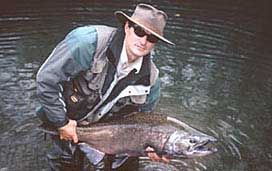 Timothy Kusherets with a Chinook Salmon.
Timothy Kusherets with a Chinook Salmon.
Salmon Organizations
Salmon fishing waters and information, by state
091924*
CALIFORNIA






